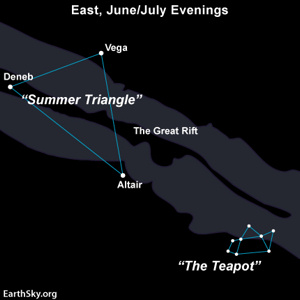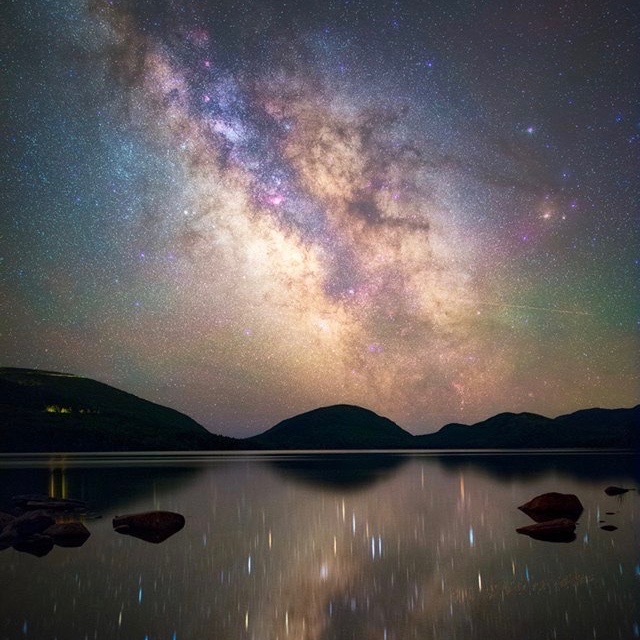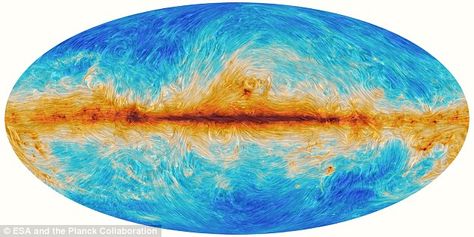Thick dust clouds block our night-time view of the Milky Way, creating what is sometimes called the Great Rift or Dark Rift. Image via NASA.
Have you ever looked up from a dark place on a starry August evening and noticed the dark areas in the Milky Way? For centuries, skywatchers pondered this Great Rift or Dark Rift, as it’s called, but today’s astronomers know it consists of dark, obscuring dust in the disk of our Milky Way galaxy.
How to see the Dark Rift. The Milky Way is easy to see if you have dark skies. It’s a shining band, stretching across the sky. If you want to see the Dark Rift, that’s easy, too, as long as you realize you aren’t looking for a bright object. You’re looking instead for dark lanes of dust, running the length of the starlit Milky Way band.

The Great Rift - also known as the Dark Rift - and the Milky Way pass through the Summer Triangle and above the Teapot asterism in Sagittarius
You will be looking south from sometime in June or July (probably) through about October – in a dark sky – and, from a Northern Hemisphere location, you’ll see the Milky Way come off the southern to southwestern horizon. Notice that the Milky Way band looks milky white. The skies aren’t really black like ink between stars in the Milky Way. You will know when you see the Dark Rift because it is as if someone took a marker and colored it darker.
The Dark Rift begins just above the constellation Sagittarius the Archer. Follow the Milky Way up until you see a black area in the Milky Way just before you get to the constellation Cygnus, which has the shape of a cross.

Photo via Manish Mamtani.
Don’t miss the Milky Way and Great Rift rise. One of the most spectacular sights is to see the Milky Way as it rises. Around 10 p.m. in June, or earlier in July and August, step outside and look in the east to see the phenomena of the Great Rift and the rest of the Milky Way make its dramatic entrance as it rises into the night skies.
Make sure you have your binoculars handy to scan the Milky Way. There are many interesting star forming regions, star clusters and millions of stars that will capture your attention.
Look in the Great Rift and imagine all the stars that will eventually reveal themselves as the molecular gas dissipates. More about that below.
Summer Triangle: Vega, Deneb, Altair

Shown is the interaction between interstellar dust in the Milky Way and the structure of our galaxy’s magnetic field, as detected by ESA’s Planck satellite over the entire sky. Image via ESA on Pinterest.
Molecular dust is the reason it is dark. Stars are formed from great clouds of gas and dust in our Milky Way galaxy and other galaxies. When we look up at the starry band of the Milky Way, and see the Dark Rift, we are looking into our galaxy’s star-forming regions. The protostars (newly forming stars) are generating molecular dust that doesn’t allow light in the visual spectrum to shine through.
However, with the advancement of telescopes that see in different light waves – such as X-rays or infrared – we now know that there’s activity in the area.
This painting shows some of the animal shapes that the Incas saw in the Dark Rift of the Milky Way. Image via Coricancha Sun Temple in Cusco/Futurism.
Ancient cultures focused on the dark not the light areas. You know those paintings where if you look at the light areas you see one thing, but in the dark areas you see something else?
The Dark Rift is a bit like that. A few ancient cultures in Central and South America saw the dark areas of the Milky Way as constellations. These dark constellations had a variety of myths associated with them. For example, one important dark constellation was Yacana the Llama. It rises above Cuzco, the ancient city of the Incas, every year in November.
By the way, the other famous area of the sky that is obscured by molecular dust is visible from the Southern Hemisphere. It’s the famous Coalsack Nebula near the Southern Cross, also known as the constellation Crux. The Coal Sack is another region of star-forming activity in our night sky – much like the Great Rift.
Bottom line: On an August night, looking edgewise into our galaxy’s disk, you’ll notice a long, dark lane dividing the bright starry band of the Milky Way. This so-called Dark Rift or Great Rift is a place where new stars are forming.
from EarthSky https://ift.tt/1NVgEud
Thick dust clouds block our night-time view of the Milky Way, creating what is sometimes called the Great Rift or Dark Rift. Image via NASA.
Have you ever looked up from a dark place on a starry August evening and noticed the dark areas in the Milky Way? For centuries, skywatchers pondered this Great Rift or Dark Rift, as it’s called, but today’s astronomers know it consists of dark, obscuring dust in the disk of our Milky Way galaxy.
How to see the Dark Rift. The Milky Way is easy to see if you have dark skies. It’s a shining band, stretching across the sky. If you want to see the Dark Rift, that’s easy, too, as long as you realize you aren’t looking for a bright object. You’re looking instead for dark lanes of dust, running the length of the starlit Milky Way band.

The Great Rift - also known as the Dark Rift - and the Milky Way pass through the Summer Triangle and above the Teapot asterism in Sagittarius
You will be looking south from sometime in June or July (probably) through about October – in a dark sky – and, from a Northern Hemisphere location, you’ll see the Milky Way come off the southern to southwestern horizon. Notice that the Milky Way band looks milky white. The skies aren’t really black like ink between stars in the Milky Way. You will know when you see the Dark Rift because it is as if someone took a marker and colored it darker.
The Dark Rift begins just above the constellation Sagittarius the Archer. Follow the Milky Way up until you see a black area in the Milky Way just before you get to the constellation Cygnus, which has the shape of a cross.

Photo via Manish Mamtani.
Don’t miss the Milky Way and Great Rift rise. One of the most spectacular sights is to see the Milky Way as it rises. Around 10 p.m. in June, or earlier in July and August, step outside and look in the east to see the phenomena of the Great Rift and the rest of the Milky Way make its dramatic entrance as it rises into the night skies.
Make sure you have your binoculars handy to scan the Milky Way. There are many interesting star forming regions, star clusters and millions of stars that will capture your attention.
Look in the Great Rift and imagine all the stars that will eventually reveal themselves as the molecular gas dissipates. More about that below.
Summer Triangle: Vega, Deneb, Altair

Shown is the interaction between interstellar dust in the Milky Way and the structure of our galaxy’s magnetic field, as detected by ESA’s Planck satellite over the entire sky. Image via ESA on Pinterest.
Molecular dust is the reason it is dark. Stars are formed from great clouds of gas and dust in our Milky Way galaxy and other galaxies. When we look up at the starry band of the Milky Way, and see the Dark Rift, we are looking into our galaxy’s star-forming regions. The protostars (newly forming stars) are generating molecular dust that doesn’t allow light in the visual spectrum to shine through.
However, with the advancement of telescopes that see in different light waves – such as X-rays or infrared – we now know that there’s activity in the area.
This painting shows some of the animal shapes that the Incas saw in the Dark Rift of the Milky Way. Image via Coricancha Sun Temple in Cusco/Futurism.
Ancient cultures focused on the dark not the light areas. You know those paintings where if you look at the light areas you see one thing, but in the dark areas you see something else?
The Dark Rift is a bit like that. A few ancient cultures in Central and South America saw the dark areas of the Milky Way as constellations. These dark constellations had a variety of myths associated with them. For example, one important dark constellation was Yacana the Llama. It rises above Cuzco, the ancient city of the Incas, every year in November.
By the way, the other famous area of the sky that is obscured by molecular dust is visible from the Southern Hemisphere. It’s the famous Coalsack Nebula near the Southern Cross, also known as the constellation Crux. The Coal Sack is another region of star-forming activity in our night sky – much like the Great Rift.
Bottom line: On an August night, looking edgewise into our galaxy’s disk, you’ll notice a long, dark lane dividing the bright starry band of the Milky Way. This so-called Dark Rift or Great Rift is a place where new stars are forming.
from EarthSky https://ift.tt/1NVgEud

Aucun commentaire:
Enregistrer un commentaire